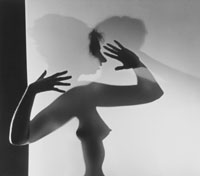Photographs we have collected and still own and some now in new homes elsewhere
Ruth Bernhard
What a doll..
Gael Newton AM, December 2024
 |
| Dead Sparrow 1946 |
Dead Sparrow 1946 by German-born American photographer Ruth Bernhard (1905-2006) is a favourite work that I bought online at one of the Dallas based Fine Art Heritage auctions in 2011. It was not cheap but I was pleased to get a signed exhibition quality print with Bernhard’s 2982 Clay Street San Francisco studio address label on the back. That label shows the print was made after 1953 and the older style of the matt warm tone paper suggests before late 1960s.
Bernhard was born in Berlin. An only child, her parents divorced when she was two. Her mother left to go to America, remarried and only saw her daughter twice in later life. Bernhard’s early life was in the affectionate care of two sisters who were teachers in Hamburg, and later at a boarding school at Jena. The sisters had many pet animals, took nature walks and trips to the seaside to collect shells. They instructed Ruth to care for her dolls like children.
Bernhard went on to study liberal arts in Bremen in 1922 and then art history and calligraphy at the Berlin Academy of Art.
Her father, a graphic designer, had moved to New York in 1921 and invited Ruth to follow in 1927.
In New York Bernhard had a short apprenticeship with Ralph Steiner a top modernist advertising photographer who had attended the Clarence H. White School of Photography that had pioneered applying photographic art expertise to commercial photography. Bernhard then worked freelance doing advertising for magazines.
She was well educated and would have absorbed some design principles from her father and learned fast. Her skill with still-life tableaux is apparent in her quirky 1933 advertisement with four rabbits for an Easter Fantasy for Macy's department store.
She made her first major personal still life Broken Shell in 1934.
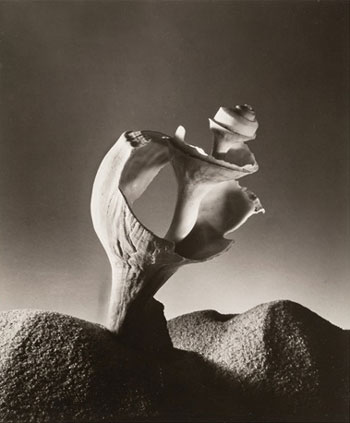 |
| Broken shell, 1934 |
By 1934 Bernhard was well regarded enough for her object photography to be commissioned to do the photographs for Machine Art - a catalogue on Industrial design at the Museum of Modern Art. The following year Bernhard visited Los Angeles with her father where she met Edward Weston and was inspired by the emotional and poetic depths photography could achieve as an art. A year later Bernhard relocated to Los Angeles and associated with Weston and his circle and also a group of puppeteers.
Bernhard’s doll studies date from her powerful 1936 tableaux Creation (aka dolls head Hollywood, CA) a striking image of a sad looking china doll’s head nestled in a female puppet hand.
Equally sombre Italian dolls and a Buddha doll feature in works from these years. One image from 1938 is of a dirty ragged doll in the street seemingly run down by a car.
 |
| Creation 1938 |
| |
| |
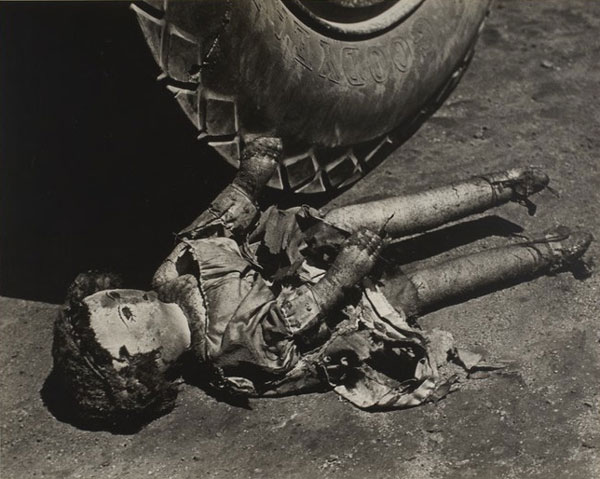 |
| On the road 1938 |
Their sadness also possibly reflects her own sense of abandonment by her mother.
Bernhard spoke of how important her childhood memories were for her work and for her sense of self: ‘I think of the dolls as children. Beloved, they represent childhood. I have as many connections regarding dolls that I make them look like children.’
In 1939 Bernhard was back in New York working for various magazines. She first exhibited as an artist in the group exhibition Sixty Photographs at the Museum of Modern Art in 1941 when one work was acquired for the collection.
Having kept up her studies of sea shells, Bernhard had an exhibition of that work in Florida. War work occupied her in 1943 and from 1945 to 1953 she associated with Alfred Stieglitz at 291 Gallery in New York, she was busy with industrial commissions and had visits to Mexico. Bernhard settled in San Francisco in 1953 setting up a studio in Clay Street and participating in the art scene.
The building still stands (right: from Google Maps). |
|
 |
Bernhard liked to work in the studio and her still life studies could be erotic, surreal, political, poetic and melancholy. Her works are far from the standard genre studies. Bernhard also made a name for luminous female nude studies.
My picture Dead Sparrow began as a commission from a remarkable doll maker Dewees Cochran (1892-1991) who used the resulting image in her 1979 autobiography As If They Might Speak.
.
Bernhard told how she thought the Cochran dolls looked sad so as the narrative cause she added a dead sparrow she found in the snow outside in Pennsylvania where she was working at the time. The dolls are only about twelve inches high so the tiny sparrow looks big. Bernhard liked Sparrow and donated a print to Princeton Art Museum.
Cochran had begun began a line of custom-made dolls modelled on wealthy client’s children in the 1930s, later moving to New York to create more affordable but high-quality range of dolls. In 1936 she created six basic Look-A-like dolls with a different face shape and by changing the hair or eyes, could produce a portrait doll to fit most white children. These were often dressed in rather old-fashioned outfits. Life magazine featured Cochran dolls on the cover of the 3 April issue 1939 with an article inside on the dollmaker.
Ruth Bernhard managed to support herself over her long career in commercial photography and as an exhibiting art photographer. From the mid 1970s interest and recognition of photography as art, ensured a succession of awards solo and group shows, monographs and an autobiography in Bernhard’s lifetime.
I met the elderly Ruth Bernhard in America she was a small thin wiry figure with a very expressive face and commanding presence. She commented on how when she went to an exhibition, she wanted to see the ‘pictures jumping’. Bernhard is a wonderful artist who has an ever-growing audience since her death. I am ordering a copy of her autobiography*.
*Carol J. Stover Ruth Bernhard: Photographer and Doll Lover Doll News Volume 47, Issue #2: Winter 1999
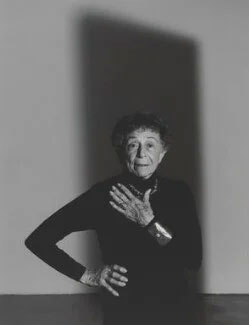 |
National portarit Gallery,
John Swannell, 1992 |
| |
links
I have written about my fondness for table top and tableaux photographs.
Ruth Bernhard relationships
Ruth Bernard, born 1905 Berlin, Germany; died 2006 San Francisco, California, USA.
International Photography Hall of Fame
New York Times Ruth Bernhard obituary
Peter Fetterman Gallery 2024 exhibition: Her The Great Women Photographers (including Ruth Bernhard)
Getty Museum collection
a few extra images by Ruth Bernhard:
 |
| |
 |
| Bears 1938 |
| |
 |
| Dolls. 1938 |
| |
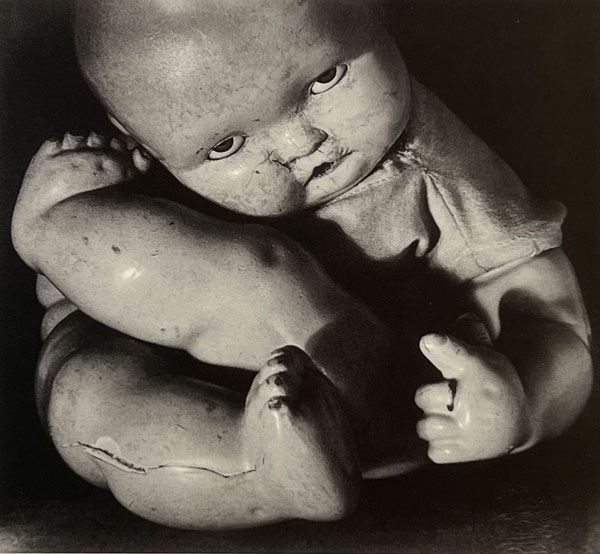 |
| Buddha Dolls. 1938 |
| |
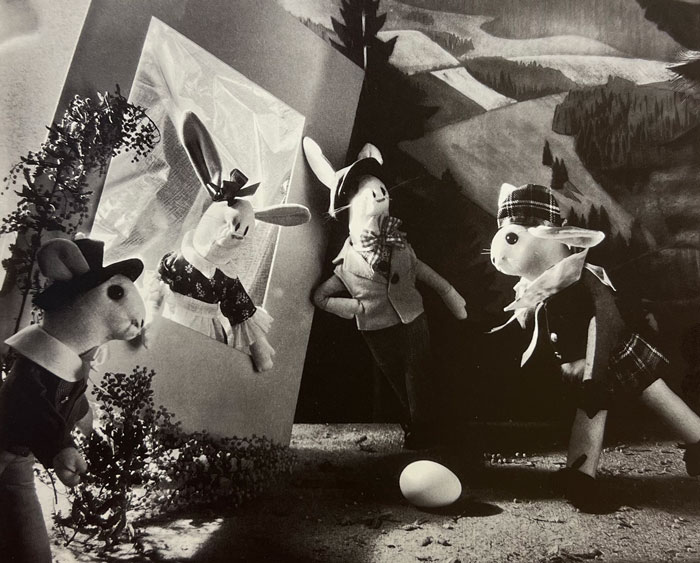 |
| Easter Fantasy for Macy's 1933 |
| |
| |
 |
| Hand and Foot 1938 |
| |
 |
| Mice, Walton and O'Rourke Puppets, 1938 |
| |
 |
| Quicksand 1937 |
| |
 |
| Portrait of Ruth Bernhard, Abraham Aronow, 1986 |
| |
| |
more of Gael Newton's Essays and Articles
|







